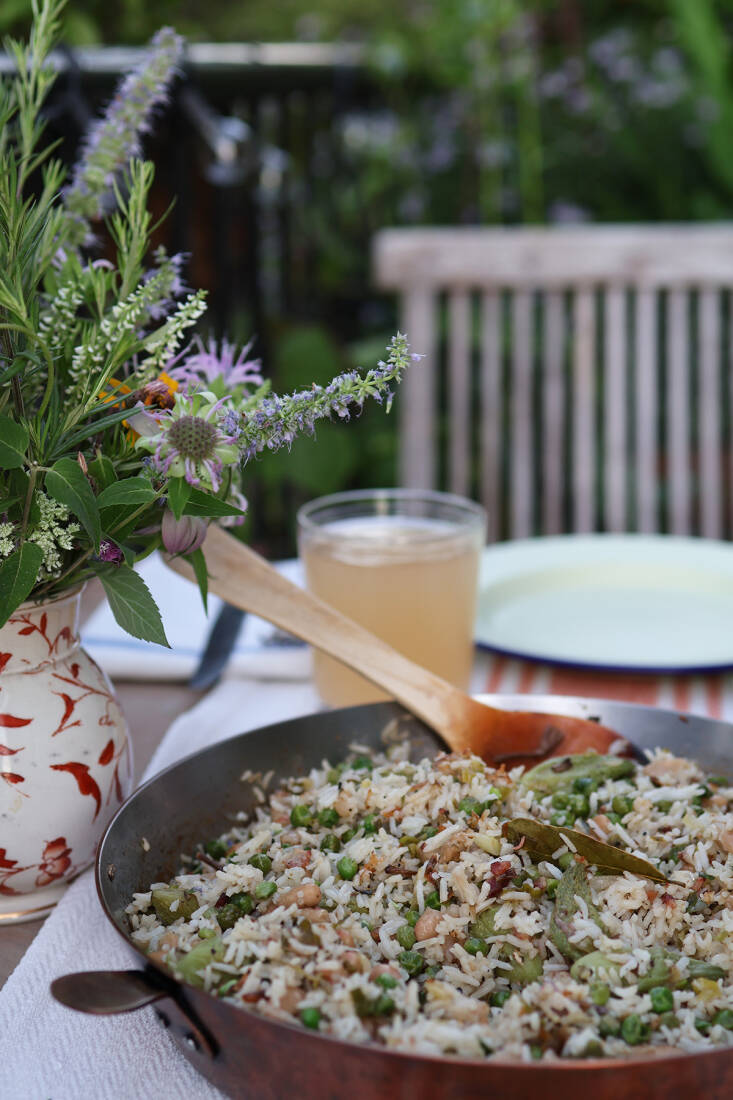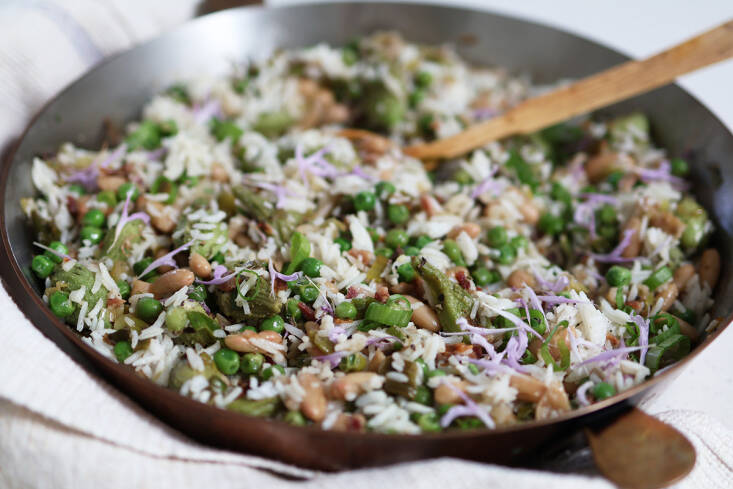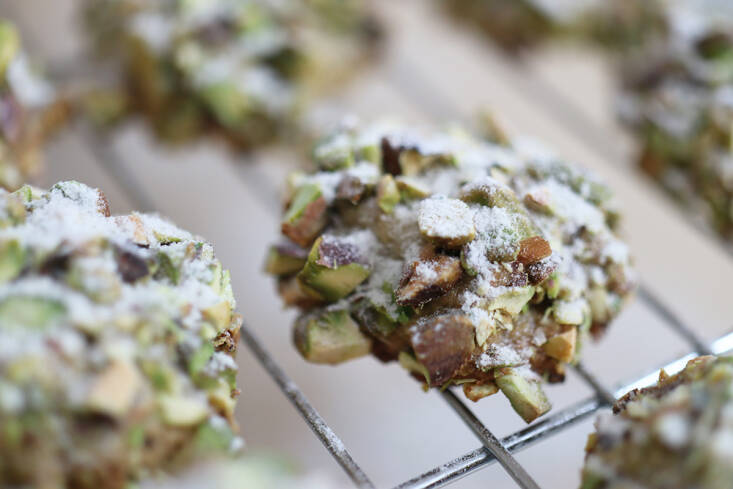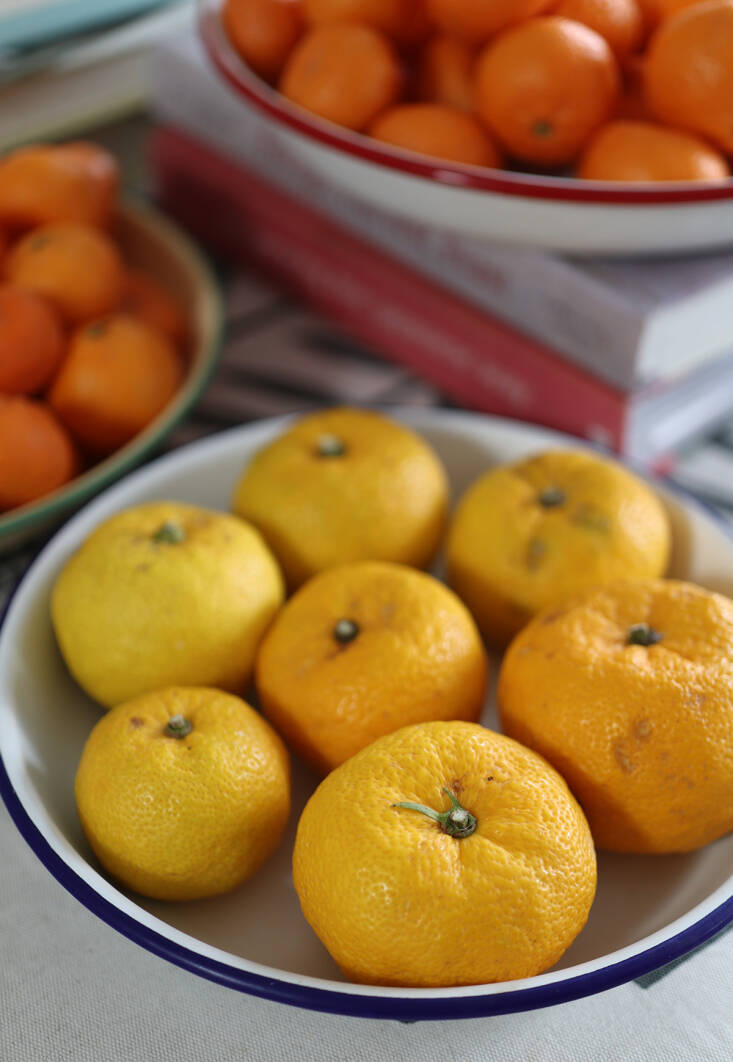Every summer, I make an evolving version of dirty rice. In our house this one-dish wonder with roots in Southern Creole cooking, always features a flavorful staple of my feral kitchen: dried daylilies. This is a culinary cross-reference of sorts: The Southern dish of reimagined and repurposed rice is adjacent to refried rice, whose East Asian association speaks to the daylilies—native to East Asia—and whose dried flowers are known as golden needle flower or golden needle vegetable in China. To make this dish in the melting pot of Brooklyn, I also draw on traditions of rice and beans, a Caribbean necessity, but eaten globally with regionally specificity wherever rice and beans occur.
Each of these rice-based dishes are economical and flavorful, making the most of whatever vegetables or herbs are available. Their spirit of comfort and care allows cooks anywhere to improvise. Aside from the starches, the only constant in my versions are the dried daylilies. Here is how to dry the flowers and a recipe for dirty daylily rice.
Above: A seasonal dish of dirty rice with dried daylilies and bee balm (it tastes like oregano), fresh peas, and common milkweed pods.
Dried dallies are exactly what they sound like: the dried flowers of Hemerocallis fulva, sometimes called ditch-lilies in the United States. While they are traditionally included in hot and sour soup, I also like to use the flowers in many other dishes, and especially in dirty rice.
 Above: Daylilies in a meadow. Hemerocallis fulva is invasive in North America.
Above: Daylilies in a meadow. Hemerocallis fulva is invasive in North America.
 Above: Spent daylilies take about a week to dry completely.
Above: Spent daylilies take about a week to dry completely.
 Above: Dried daylilies smell a little like carob.
Above: Dried daylilies smell a little like carob.
Their aroma after drying is reminiscent of carob, or of milk chocolate (at least, to me). They add a layer of summer perfume to my dirty rice, while other seasonal-shifting ingredients help build this comforting meal: summer mushrooms like chanterelles or chicken of the woods, the new season’s peas, young common milkweed pods, oregano-redolent bee balm, or more conventional herbs from our terrace, like marjoram, or thyme. The rice may also be fortified by legumes, like white beans, or chickpeas.
 Above: Daylilies with three stages of flower—bud, bloom, and spent flower.
Above: Daylilies with three stages of flower—bud, bloom, and spent flower.
There are two ways to dry daylilies. One is to collect flowers that are already spent. Not to overstate a seemingly obvious point, but daylilies bloom for just one day. The next day, they hang limp, their petals closed. Collecting these wilted flowers is an easy way to begin the drying process, and doesn’t spoil the daylily show, if you—or others—enjoy their blazing flowers. You can also return and collect flowers as they become limp, adding to your stash at home.
Otherwise, if your daylily patch is substantial (Hemerocallis fulva is invasive in North America), collect fresh, open flowers. They will fold within the day.
 Above: As the flowers dry, they shrink. Drying takes about a week, at room temperature.
Above: As the flowers dry, they shrink. Drying takes about a week, at room temperature.
To dry daylilies, arrange the spent flowers in a single layer on parchment or cloth, or on a baking tray or large clean platter. Turn them once a day. When they feel paper-dry, usually after about a week, transfer their narrow, brittle forms into a jar, and close the lid very tightly. When you open that lid again give them a good sniff. Carob! They last impeccably in an unopened jar for (at least) two years.
 Above: A summer supper of dirty daylily rice.
Above: A summer supper of dirty daylily rice.
Dirty Rice and Beans with Daylilies
Serves 4
Adapted from Forage, Harvest, Feast – A Wild-Inspired Cuisine
You may have leftover rice begging for reinvention, but I usually cook it from scratch for dirty rice. My go-to is basmati, a long-grain rice. If you prefer use another type, follow those instructions for water-to-rice ratio. Fresh bay leaves add an incomparable flavor to the rice (learn how to grow indoor bay here). And if you grow your own common milkweed, blanch the tender, immature seedpods for 3 minutes to add to this dirty rice. Feel free to add vegetables like celery or carrot; just make sure to chop them very finely and to sauté them well before adding the rice. Don’t skimp on the oil: it conveys a silky texture and carries all the flavor.
Rice
- 1 Tablespoon vegetable oil (I use avocado)
- 1 1/2 cups basmati rice
- 2 1/4 cups water
- 4 fresh bay leaves
Dirty Rice and Beans
- 3 strips smoked bacon, cut into thin strips
- 3 Tablespoons vegetable oil
- 2 cups scallions, finely chopped
- 1/4 cup dried daylilies, crushed or chopped (about 8 dry daylilies)
- 1 14-oz can cooked beans or pigeon peas, rinsed well
- 3 cups cooked basmati rice
- 2 cups fresh green peas, cooked
- 2 cups cooked common milkweed pods (optional)
- 2 – 3 Tablespoons lemon juice
- 1 Tablespoon bee balm flowers and leaves (or chopped oregano)
- 1/2 teaspoon salt
- Black pepper
For the rice: In a pot over medium heat, heat the oil and add the rice. Toast the rice for 2 minutes, tossing a few times. Add the water and the bay leaves, and increase the heat to high. Cover the pot. When the water boils, turn the heat down to its lowest setting and continue to cook until all the water has been absorbed. Turn off the heat. The rice can be made a day in advance in advance, but keep it cold until needed.
For the dirty rice and beans: In a large skillet over medium-high heat, cook the pieces of bacon until their fat begins to render, about 4 to 5 minutes. Lower the heat to medium and add the vegetable oil to the bacon fat. Add 1 1/2 cups of the scallions, reserving some greens, and stir well. Cook for 5 minutes, stirring occasionally. Add the dried daylilies and the rinsed beans and stir well. Stir in the the rice, peas, milkweed pods (if using), and add the lemon juice, bee balm, and lsat. stir well. Continue to cook until heated through. Add the last 1/2-cup of scallion greens and stir one more time. Taste for seasoning and add more salt, if necessary, with a generous amount of freshly-ground black pepper.
See also:



